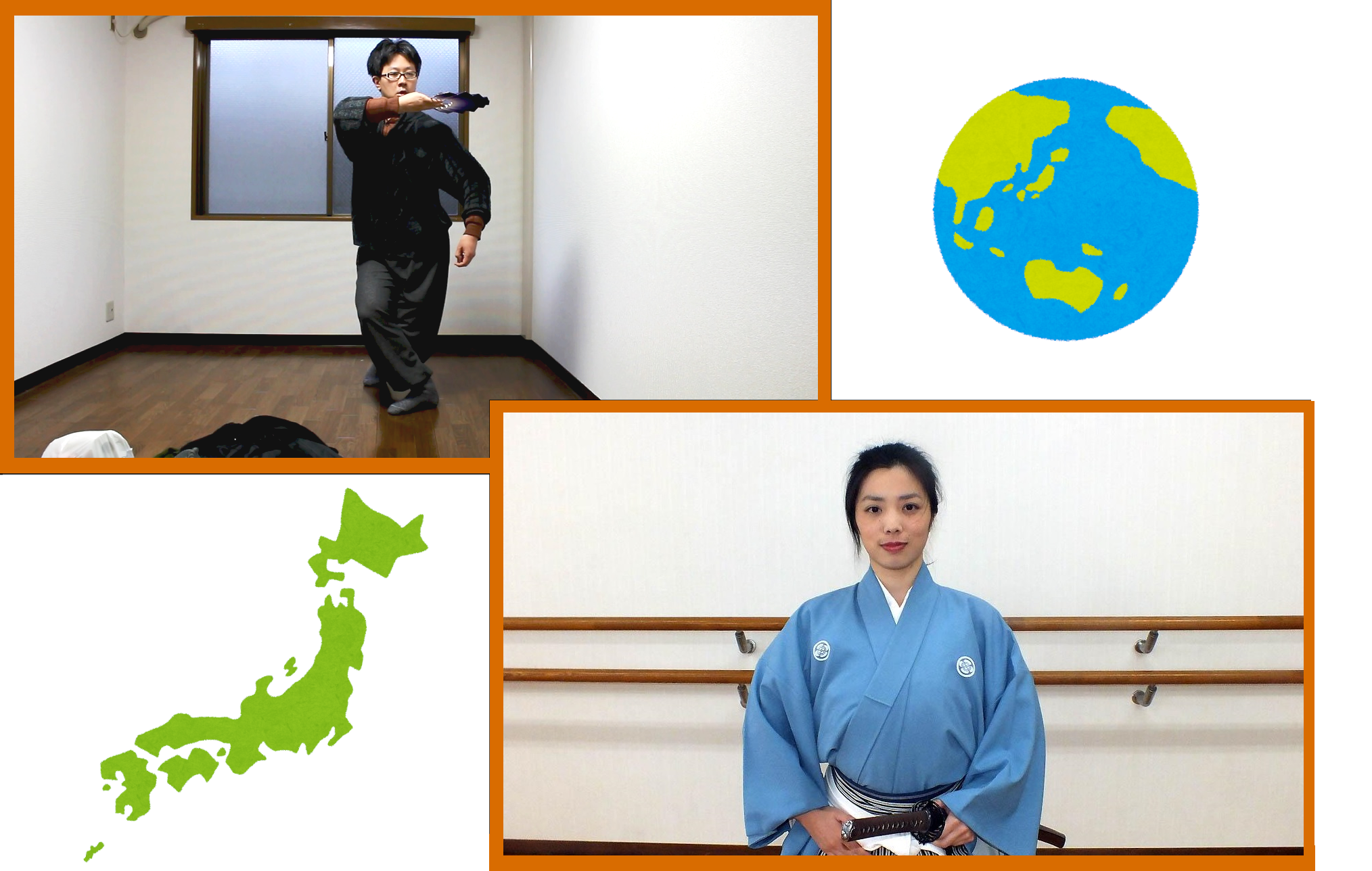Online Kenbu School HARUKA
Samurai Kenbu Online Classes
Instructors at Samurai Kenbu Theater, who have obtained diplomas at one of the Kenbu schools among more than 100 schools in Japan,
will provide remote instruction using Google Meet.
Let’s learn a piece of Kenbu: “Nipponto.” A 3-month (12-time) course for beginners

What is the goal?
At this course, you will complete a kenbu piece, called “Nipponto”, which means “the Japanese sword”. This poem was written by Otori Keisuke, who was the samurai in the late 19th century, and who fought in the Meiji restoration.
The poem of Nipponto:
- Japanese:
- Tanya kenmasu iku hyakkai Soho sanjaku tamani chirinashi
Utagawazu Nipponto Sairinaruo Katute bankonsakusetu kokoromi kitaru - Summary:
- Otori shows a respect to his sword, which was forged well by a swordsmith, and which fought hard with him in battle.
How to start
- 1. Enquiry
- Make an enquiry by e-mail to: info(at)samurai-kenbu.jp and apply for a Trial lesson (fee: JPY1,000).
- 2. Trial lesson (private) & counseling (40 min)
- First, we will ask you about your goals and purpose of learning kenbu. Next, we will discuss your training environment (days and times of the week, room size and ceiling height, and equipment you have). You can then experience the actual content of the lesson.What to bring: A sword or stick-like object (two pieces of newspaper rolled up and connected is best) and an obi (pants belt is acceptable).
- 3. Apply for a course
- After the trial lesson, please let us know the date and time you wish to take the first class by e-mail. Once the date and time are set, we will send you an invoice for the fee by e-mail. (Please pay by credit card or bank transfer.) At the same time, we will also accept orders for the sword, fans, and other tools you will need.
⇒Start your lessons! Let’s enjoy practicing
The Lesson contents
Basic practice of Katana
Even if you don’t have a sword, you can participate with a stick.
- -Basic skill of the sword, without using the scabbard.
- -Sword skills: Makko, Kesa, Tsuki, Doh
- -Manner of the sword
Basic lesson on Mai (dance) movements
You will learn the basics of how to use your body, such as:
Surisashi, Kakarisashi, hanmi, keridashi, Samurai walk
Practice of kata and choreography
Now it’s time to practice a piece! The first 15-20 minutes will be spent practicing the kata, and the remaining 20-25 minutes will be spent learning the choreography.
Completion of a piece!
Once you have learned the choreography and are able to perform the piece by yourself, you will practice repeatedly to the music to perfect the piece and improve your skills.
Price
- •Trial (40 min × 1 lesson) JPY1,000
- •Beginners 12 time course (40 min × 12 lessons ) JPY 30,000 *4 months valid
- •Continuing course (4 times/month) JPY9,000
- •Additional private lesson: JPY3000/per lesson
Sets of equipment
- •Pack A: Belt and tabi-socks: from JPY5,500
- •Pack B: Sword, belt, and tabi-socks: from JPY40,000
- •Pack C: Sword, belt, tabi-socks, kimono and hakama-pants: from JPY55,000
-A sword (or a rod)-
We use a sword called Iaito, a sword for martial arts called Iaido. Its blade is not sharp, but the shape is the same as a genuine sword. The price is $300 and up. We guess you cannot get it immediately, so first just prepare something like a sword, such as a wooden rod. The length should be from your hip to your ankle.
-A belt-
To keep the sword by your side, you have to use a belt. When you wear a Kimono and a Hakama, you insert the sword into a belt called Kakuobi, a belt to suspend the Hakama, or you can also put another softer belt on your Hakama. At the training, you can use your belt for trousers, or get a 6-8 cm wide cloth to use as a belt,if possible.
About the Continuing course
At the continuing course, the instructor will choose the piece you will learn, based on the tools you have, your needs, and your skills.
The practice to improve the level of refinement is a never-ending process, but at the beginning stage of learning, it is better to experience various pieces than to stick to one piece, so the instructor announces “pass” at a certain level of performance.
In between the practice sessions, there will be theme-specific lessons such as “sword handling,” “fan handling,” “suriashi walking,” and others.
Admission policy
- •This is designed for those of you who want to learn Kenbu:
Kenbu is a performing art that originated in the martial arts. You will learn some elements of martial arts, but the goal is to perform it as a dance, so it is not suitable for those who “only” want to learn martial arts. (It doesn’t matter if you learn short-term or long-term.)
- •Those who have a generous attitude to our instructors’ imperfect English:
It is said that Japanese people are not good at English, particularly when it comes to listening. Our instructors talked with more than 5,000 foreigners annually at the Samurai Kembu Theater in English, but most of them still feel English is very difficult for them. If they cannot catch what you are saying, or cannot communicate what they want to say, they will use text chat tools, etc. Please be generous about it and let’s make an effort to have good communication. If you have any problems, please contact our support service. (A native English speaker or someone who speaks English well will respond.)
